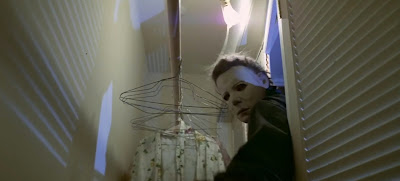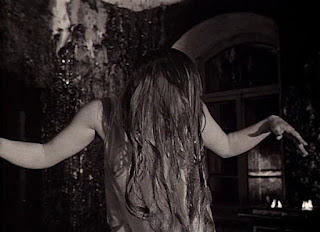The Shining/Repulsion - The Evolution Of Horror
Thoughts On: The Shining (1980) & Repulsion (1965)
A continuation of the previous post.








A continuation of the previous post.


It has become apparent to me that, across a few posts, I've been building towards something of a point. My last four post on horror films looked at The Last House On The Left, The Wolf Man, Black Sabbath and then The House Of Ghosts and Outer Space. And in looking at these films I've been identifying what I like about horror and areas in which it can possibly be improved. I of course don't mean to suggest that I have all the answers, just some sense of a theory on how horror films could change. And so, what I mean to do now by looking at my two favourite horror films, is suggest something of an idealistic change in horror as a genre.
So, as I've said before, I'm not a big fan of horror films. The main issue, the age-old issue, with horror is that it is a form of fantasy, but one that is very difficult to project. This is because horror needs realism to be visceral and impactful, but fantasy needs freedom to be immersive and captivating. In The Wolf Man, I try to suggest a different approach to script and direction that has a concentration on turning horrific details into images of sensory information - a way of writing that puts the screenwriter in the boots of a character so they may write from a more genuine place. I believe this would greatly improve the action in horror films and reverse the trope that suggests all horror movie characters have to be dumb. A good example of where this improvement could be made is the infamous closet scene in Halloween.
Laurie gets into this position after thinking Myers was killed. She finds the kids and tries to console them and - BAM - there's Mike. Her reaction is to run into the room here, push Tommy and Lindsey into a closet and get them to lock themselves in. Ok. Stop. You may be thinking that this is an awful decision and that Laurie is essentially dealing these two kids a death sentence. Well, she isn't. She can't climb out of the window she implies she could - not with the two kids. So, this decision she makes here is probably the best she could have made under such pressure. HOWEVER, we need some registry of the difficulty of this decision through cinematic language. In such, we shouldn't have just seen her push the kids in the closet and tell them to lock the door (and, yeah, Myers would have heard that). We should have at least had a close-up that expressed Laurie's fear and uncertainty as she pushed the kids in. Moreover, the moment in which Myers walks into the room could have been elongated - he could have looked out the window. And in that moment, we could have been given an image of the kids' closet in the background to add further tension. We don't get any of this, however. This is because Carpenter was probably more focused on this excellent set-piece in the closet - which is great. But, he shouldn't have forgotten character as, from this iffy decision of Laurie's, could have come a lot more tension.
What I'm beginning to imply is a more character-centric kind of horror. This is how I believe horror scripts can be better written. When it comes to direction and editing, we should take a quick look back to the last post on physical-interactive cinema. In this post I talk about a form of cinema that is best represented by the comedy-horror experiences you could get in the early silent era.
These films knew they effected their audience in a physical way - they had jump scares - but, embraced this with their interactive nature - like the breaks of the fourth wall and the understanding that these are contrived experiences. This approach to cinema has not really evolved, and I suggest how it could possibly do this by learning from the narrative approach taken by films of the exploitation period around the 70s and by adopting formal strategies from Peter Tscherkassky, who uses a very physical and tangible kind of cinematic language.
In such, a new form of impressionistic exploitation picture could be developed where characters are used as explicit vessels for us to truly experience horror through. The importance of exploitation here would emphasise the boundary pushing (using new technology) that could be opened up with a new formal approach of physical and tangible form - as implied by Tscherkassky's work. I could see this opening up the fun side of horror films and re-introducing the idea of experience. After all, I have never sat down to watch a modern horror film and felt anything like the interactivity and dare/challenge dichotomy present in exploitation pictures.
Ok, by now, we've covered, in brief detail, the major points discussed in each of the previous posts. However, whilst I believe the experience of horror films needs to evolve and that this is a possible way in which that may occur, I recognise that I've completely disregarded a whole other class of horror - a class briefly touched on with the reference to the 1910 version of Frankenstein. This is why I bring all of this up under the guise of Repulsion and The Shining. Neither of these films have an exploitation or physical-interactive basis. They certainly have elements of jump scares, gore, exploitation and entertaining horror, but, what makes these films great is their psychological and 'artistic' side. In such, what we see in The Shining and Repulsion is a somewhat modernist approach to horror. Modernist films, like 8 1/2, Cries & Whispers, The Mirror, Ordet and Persona, all handle character in a manner that very few other movies do. They push into a psychological space to represent characters through cinematic imagery. Just look to the opening of 8 1/2...
... the flashbacks of Cries & Whispers...
... the construction of memory in The Mirror...
... the resolution of Ordet...
... the opening of Persona...
All of these scenes and details are representations of the best cinema has to offer; you do not get to be more cinematically profound than Bergman, Tarkovsky, Dreyer and Fellini. There are very few that step up to this modernist height of cinema. We get the surrealists like Buñuel...
... we also have Lynch, Jodorowsky, Kurosawa and a handful of other masters...
However, how many horror films fit into this realm? In my opinion, very few. The only two I know can confidently cite are...
What these two film do is build upon the classical horror films like Frankenstein, Dracula, The Cabinet Of Dr. Caligari and Nosferatu by injecting a tangibly psychological element into them. This works so successfully as it understands the narrative focus of these kinds of films - that which films such as The House Of Ghosts, The Haunted Castle or even The Last House On The Left and The Night Of The Living Dead do not have. In such, physical-interactive and exploitation cinema do not have that sense of being an 'actual film'.Whilst the late 80s and 90s Batman films where just comic book movies...



... Nolan's trilogy is more widely accepted as 'actual films'...



And I see this dichotomy to be true when you compare Halloween, The Wolf Man, The Last House On The Left or Black Sabbath to The Shining or Repulsion. And so, what I ultimately think would allow horror as a genre to evolve further would be the incorporation of all we've discussed in relation to exploitation, the problem with fantasy and horror, the jump scare and psychical-interactive cinema into 'true narratives' - traditional narratives with a modernist twist. In such, all surrealism, action, fantasy, psychical-interactivity and entertainment can be funneled into narratives that have psychological, character-centric foundations, but impressionistic forms that learn from exploitation. The type of film I then mean to imply that needs to be created is equivalent to The Shining or Repulsion, but technologically updated and approached through a variety of formal pathways.
What I ultimately mean to implore here isn't simple and should not result in one film, but a movement based on a philosophy of the horror film as an important genre that can funnel through it psychology, character, surrealism, absurdism, fantasy, religion, myth, monsters, meaning, subtext and so much more. The reason why, though I am not a huge fan of the genre, I am incredibly interested with horror as a concept is that it is a genre that is almost as versatile as science fiction - my favourite genre. Horror has that aspect of fantasy that sci-fi does, but doesn't have that same need for realism and verisimilitude. And because of this, horror should be a playground for filmmakers willing to make great movies for adults. By taking the impressionistic/modernist approach I mean to imply that horror films can do and be so much more - all whilst having substance. So, just as Repulsion and The Shining are deeply immersive and entertaining, they have subtext and a lot of depth. Why can't all horror films have this as well as play with formal strategies? After all, there are so many parts and avenues to explore that I've tried to outline. These different ingredients can be applied in differing ratios to produce a more respectable image around horror. Horror doesn't have to mean cheap fun, it doesn't have to mean dumb movies with dumb characters, dumb plot lines and dumb audiences. Horror as a genre has so much more going for it than what is capitalised on in contemporary, mainstream cinema.
So, to you who is reading this, do you think horror movies could be better? Do I make any sense, or are there other avenues and possibilities I've overlooked?
If you missed any posts I've discussed, or want to get a better perspective on the many elements to this post, check out:
Previous post:
Next post:
More from me:



























